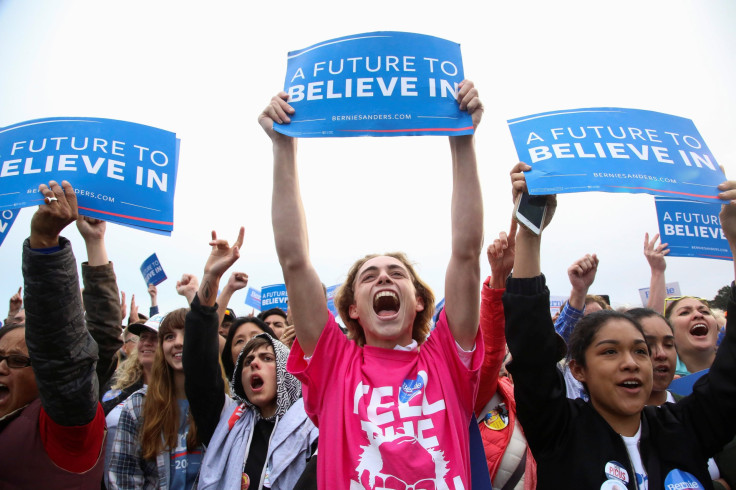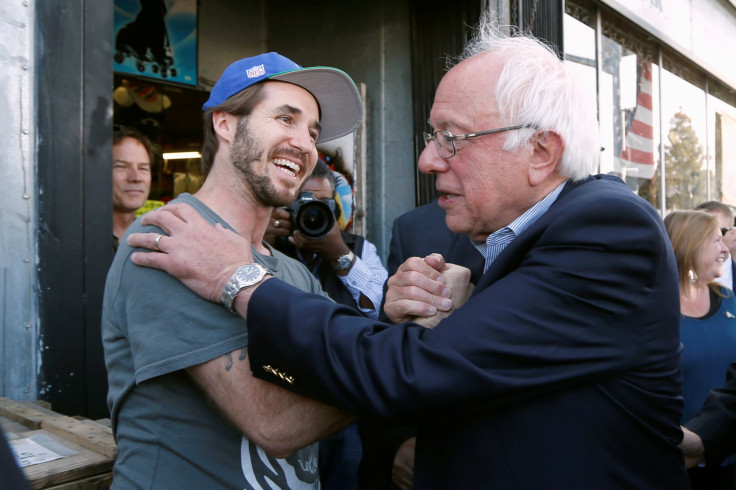How Bernie Sanders Changed Democratic Fundraising, Beating Hillary Clinton’s Total

It’s all over but the haggling. Tuesday’s election-night victories finally pushed Hillary Clinton over the top, adding more pledged delegates to her tally and all but guaranteeing her the Democratic presidential nomination.
Opponent Bernie Sanders has vowed to keep fighting, lobbying Clinton’s superdelegates in the hope that they will move to his corner. But reversing Clinton’s majority in the scant weeks before the convention is probably impossible. Among superdelegates, she leads Sanders by about 500 votes. There is no precedent for a majority of superdelegates suddenly flipping their allegiance to the candidate who lost the popular vote.
In other words, it’s time to call it. By the time Clinton announced her candidacy, she was already the probable nominee; now she’s the presumptive nominee. But while the intervening months did little to change that calculus, they did change the party. Democratic fundraising, in particular, may never be the same.
Bernie Sanders’ fundraising machine generated more than $200 million for the candidate over the past year, with the vast majority of that sum coming from small donors. By making those small donors the core of his fundraising strategy, Sanders bypassed the traditional gatekeepers who typically pick the survivors of the so-called money primary.
“It’s great fundraising. It’s the purest kind of fundraising you can have, because nobody’s buying you,” Elaine Kamarck, a senior fellow at the Brookings Institution and a pro-Clinton superdelegate, told International Business Times. “It’s terrific.”

Clinton has pursued a more traditional revenue-generating strategy, which meant relying on money raised from the hundreds of fundraisers her supporters hosted on her behalf (and on behalf of pro-Clinton super PACs). Such fundraisers can sometimes require a commitment of $1,000 or more just to get past security, but this year those sums were matched by the truckloads of small-denomination cash being provided to the Sanders campaign.
Though Sanders eschewed fundraisers, he was nonetheless a match for Clinton in fundraising throughout the campaign. In several months, disclosure forms show that he trounced her in the race for cash.The most recent Federal Election Commission data shows he has raised slightly more than she did over the course of the campaign, though the total does not include money raised for super PACs favoring one candidate or the other.
As a result, Sanders was able to race further and harder than any comparable left-wing challenger in recent memory. Twelve years ago, one of the Sanders campaign's direct ancestors — the presidential candidacy of anti-war Vermont Gov. Howard Dean — came to an abrupt end after a disappointing showing in the February Wisconsin primary. In contrast, Sanders marshaled the financial resources to withstand any one isolated setback.
Election law expert Rick Hasen, a professor of law and political science at the University of California, Irvine, has written that the inordinate influence of money in politics can sustain candidates well past their expiration date. He observed in a January op-ed for the Washington Post that support from casino mogul Sheldon Adelson almost single-handedly sustained Newt Gingrich’s 2012 presidential campaign “and gave voters a second and third and fourth look at the candidate.”
Sanders’ fundraising machine generated more than $200 million for the candidate over the past year.
Sanders is a different story, Hasen told IBT.
“Gingrich was able to stay in the race not because Republican voters wanted it, but because Sheldon Adelson wanted it,” said Hasen in an email. “Here, millions of people (even if not a majority of Democrats) want Sanders to stay in and win.”
Generating that kind of broad-based enthusiasm isn’t easy. John Nichols, national affairs correspondent for the Nation (which endorsed Bernie Sanders), said passion and social media outreach are both key.
“One of the reasons why Sanders got so far is that his supporters really tapped into Twitter, Facebook, Reddit and a host of other platforms and vehicles,” Nichols told IBT.
By doing so, the Sanders campaign and its fans were simply going further down the path trod by a previous Democratic candidate, he said.

“Social media was an incredibly powerful tool for Barack Obama,” said Nichols. “For voter mobilization in 2008, and for fundraising and voter mobilization in 2012.”
But Sanders has taken the netroots strategy employed by Obama — not to mention Howard Dean — into new territory. Almost 2.5 million people have donated to his campaign; progressive candidates and advocacy groups across the country are champing at the bit for the opportunity to raise money off his donor list.
That list alone could provide a cash infusion into the broader progressive infrastructure. As for future Democratic primaries, there is a good chance that other left-leaning presidential candidates will use the Sanders fundraising model to powerful effect — but only if they can generate the same level of passion that Sanders did.
“If you’ve got something unique and appealing about you, it attracts the money,” said Kamarck. “I’m not sure you can manufacture that.”
© Copyright IBTimes 2024. All rights reserved.












